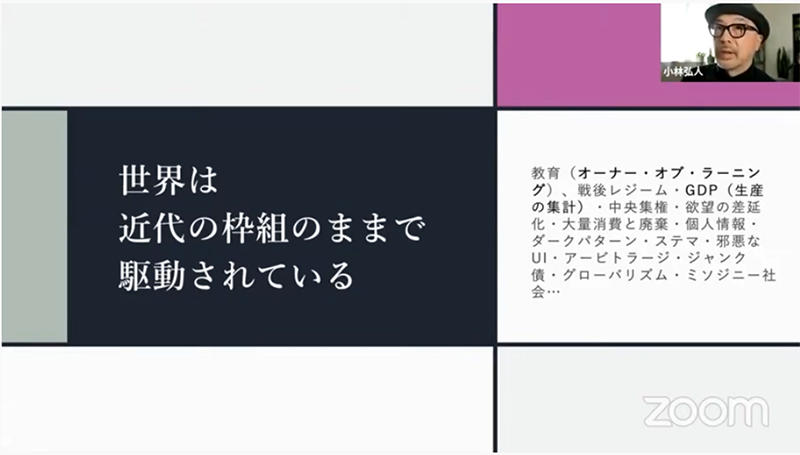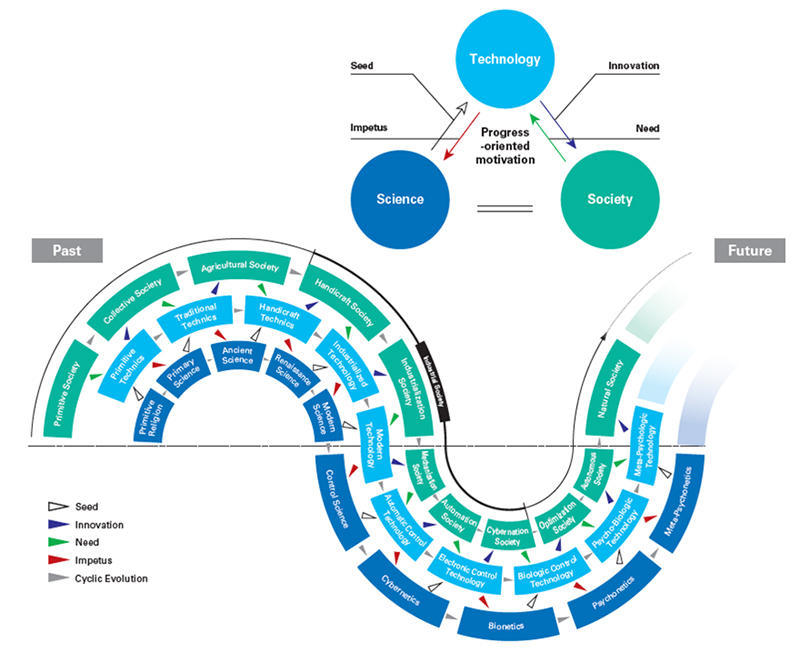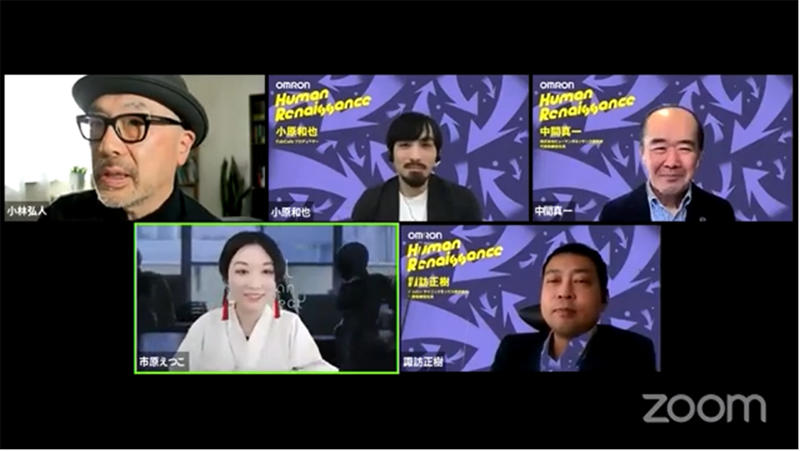
On January 25, 2021, an online event "OMRON Human Renaissance Vol. 1." was held. Enhancing human creativity and potential and striving for a world of harmony between humans and machines, OMRON held the event to explore questions about creating the future and to think together about a vision of where we want to be. Based on the theme of "Human, Social, and Technological Renaissance," Session 1 consisted of two presentations titled "After GAFA and SINIC Theory" and "On SINIC Theory" respectively, and Session 2 featured a discussion with two special guests. Here is an overview of the event.
Hiroto Kobayashi, representative director and CVO of INFOBAHN Inc., gave a presentation on the theme of "After GAFA." Kobayashi is a media pioneer who has launched ventures such as WIRED JAPAN and GIZMODO JAPAN. He believes that now is a "time of transition to a new era where we will recover what we have lost; in other words, a renaissance."

This transition has already begun, and the movement towards a new era following the height of the GAFA-dominated platform era is accelerating. This is exemplified in Web 3.0, a blockchain-based decentralized internet that can be trusted and mitigates fraud risk. Overly concentrated systems such as the GAFA platforms can create both political and ethical problems, so transition to a decentralized system is being explored. The sharing economy has expanded beyond merely matching services that exploit gig workers and has given rise to a "platform cooperativism"*1 movement. Other countries are testing out self-sovereign identity, in which each individual manages their own personal information.
Kobayashi also described what he calls a "recycling society," in which the economy is switched to a circular economy that considers environmental impacts and "ethical supply chains"*2 are built. In this new form of society, a brand's value will be assessed not only by the quality of products and services, but also by whether it is ethical or not. He believes that the trend of breaking out of the modern paradigm that was created during the industrial revolution and moving toward a new paradigm is becoming gradually more prominent.
And what would this future look like? Kobayashi gives several possible examples: "locally sourced and consumed industry" where companies build factories in the area where their products are consumed and hire local workers, "reverse experience" where one can relive black boxed manufacturing processes, and "bagless supermarkets" where customers take their purchases home without putting them in a bag. He ended his presentation saying that centralized and multipolar decentralized structures would coexist in layers and working styles in such a society would be autonomous and collaborative.
This was followed by Shinichi Nakama of Human Renaissance Institute Co., Ltd. giving a presentation on a vision of the future based on "SINIC theory"--a model for predicting the future proposed by OMRON in 1970. This ended Session 1. Session 2 consisted of a discussion between the presenters and two special guests.
*1 Online platform co-ops operated through investments between individuals.
*2 A supply chain that is both environmentally and socially ethical.

Moderated by Kazuya Ohara (commonly called as "Benkei") of FabCafe MTRL, the discussion was between the two presenters in Session 1, media artist Etsuko Ichihara, and OMRON SINIC X Corporation's President and CEO Masaki Suwa.

The discussion was started off by Etsuko Ichihara. She began by talking about the compatibility between SINIC theory and her vision for society, which she refers to as "hyperactive primitive society." Ichihara explained that the concept of "hyperactive primitive society" corresponds to a society where SINIC theory has been optimized. She predicts that society will transform from one that pursues productivity and efficiency to a society that emphasizes self-actualization and new ways of living as humans.
In response, Hiroto Kobayashi said that we are already beginning to see signs of this "hyperactive primitive society," and explained that it is compatible with the "helix structure" and mindset advocated by SINIC theory.
Benkei then asked Masaki Suwa about new challenges in technological development. Suwa responded, "For the first time in human history, a society will emerge where humans live with non-human intelligence" and "a society will emerge where technological evolution will accelerate harmony and integration between humans and machines." After expressing his prediction that the first person to run the 100-meter dash in under 9 seconds will be a Paralympic athlete as an example, he explained that the new challenge will be how to embrace this future society where machines and humans are integrated in such circumstances. However, he also pointed out that humans becoming weaker due to integration with machines is an issue that comes up in SINIC theory. He emphasized that OMRON's position was to promote harmony between machines and humans while considering both negative and positive impacts.
OMRON's founder Kazuma Tateishi once said, "To the machine, the work of the machine; to humankind, the thrill of unfettered creativity." How will the evolution of technology change our views of what it means to be human?
In response to this question, Ichihara expressed interest in the concept of "harmony between humans and machines" mentioned by Shinichi Nakama in his explanation of SINIC theory. In her Digital Shaman project, Ichihara created a household robot in which you input the physical features and contents of conversations of a deceased person, and it lives with the bereaved family for 49 days after death. Although robots like this tend to make people in Europe unfamiliar, in Japan they have been accepted with little resistance. In her view this distinct Japanese mindset correlates to "Psycho-Biologic Technics" in SINIC theory. In response, Nakama said that we are beginning to see the signs of psycho-biologic technics and meta-psychologic technics with AR and VR.
Kobayashi mentioned the possibility of technological progress producing "new time." The evolution of technology increases free time for people. The question here, however, is how people spend that spare time; how it is spent reveals what people value most. Kobayashi pointed out that a uniquely human characteristic is the inefficiency of how we use time, something which is unpredictable by AI.
Suwa's response to Benkei's question was that machines do not understand "slow and steady wins the race." Part of what makes us human is how we embrace inefficiency and do not simply throw it out as being "in"-efficient.
Nakama brought up the importance of education. In today's rapidly changing society, huge changes will continue to occur in our lifetimes. In order to survive today, people need to keep learning throughout their lives.
Ichihara asserted that we should admit that "humans are actually a peculiar animal." She said that the vision of the future predicted by SINIC theory is the conceptualization of a new paradigm where human emotion and desire are visualized and value is added and expressing there will be a hopeful future.
Kobayashi ended the discussion saying that the role of humans is to attach meaning in all situations, which is something AI cannot do, and curiosity and imagination are essential for finding meaning of human role.